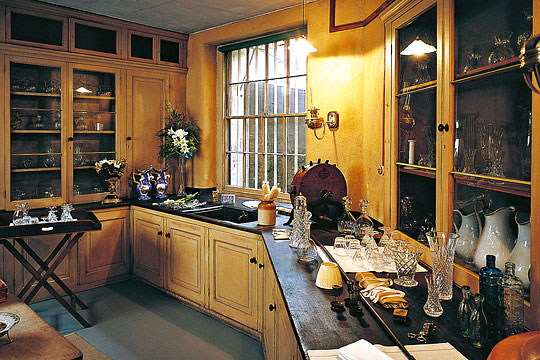Research on Osborne
Since 1986 Osborne has been in the care of English Heritage, which continues to research and conserve it. Though much work has been done on the collection, in collaboration with the Royal Collection, there are gaps in our knowledge about the ways in which the house has been used.

Research To Date
The House
Osborne was well known in the 19th century and was depicted with varying degrees of accuracy in numerous contemporary engravings and prints. Most antiquarian accounts focus on the lineage and history of the families who owned Osborne and only briefly or incidentally describe the buildings.[1]
Appreciation of the Victorian period, together with its art and architecture, reached a nadir during the years following the Second World War. A post-war revival, however, came about with a renewed interest in the history of the country house and with the creation of the Victorian Society, set up in 1958 to promote the architectural and artistic achievements of the period. Research into the building of Osborne by Mark Girouard and Hermione Hobhouse resulted in a number of publications.[2]
In recent years various aspects of the house have been researched:
- The use of the Table Deckers’ Rooms, before they were opened to the public for the first time in 1999[3]
- The occupation and use of the main and household wings[4]
- The construction, development and use of the kitchen and other service areas[5]
- The Swiss Cottage, Swiss Cottage Museum and their collections.[6]
Several surveys of the buildings and the larger estate have been undertaken, chiefly recorded in the Osborne House conservation plan.[7]
The Collection
The collection, though well documented in the 19th and early 20th centuries,[8] then fell victim to a certain extent to changes in taste. Although certain pieces continued to claim attention, and the principal items still featured in the guidebooks, the collection as a whole was rather disregarded.
In the 1960s, however, Edward Sibbick began researching the contents of the house, and eventually produced a 25-volume typescript catalogue.[9] Later the principal oil paintings were included in Sir Oliver Millar’s catalogue of the Victorian pictures in the Royal Collection.[10] A few years later the watercolours were covered by Delia Millar’s catalogue.[11]
An exhibition about Queen Victoria and Prince Albert as art collectors and patrons took place at the Queen’s Gallery, Buckingham Palace, in 2010. The accompanying catalogue includes several pieces that were acquired by the royal couple for Osborne.[12]
Questions for Future Research
Areas of Osborne’s history that would merit further research include:
- The use of the house by the royal household
- The role of Osborne within the political life of Britain and the Empire, 1845–1901
- The use of the house by the ‘below stairs’ staff
- An understanding of the built structures within the estate
- The use of Osborne by the King Edward VII Convalescent Home for Officers, 1904–2000.
READ MORE ABOUT OSBORNE
Footnotes
1. FGS Groves, ‘Osborne Isle of Wight and the families who have held it’, Hampshire Notes and Queries, 7 (1893), 139–47.
2. M Girouard, The Victorian Country House (London and New Haven, 1971); H Hobhouse, Thomas Cubitt: Master Builder (1971; revised edn London, 1995).
3. R Shepherd, ‘The Servery and Tabledeckers’ Rooms at Osborne House’, unpublished report (English Heritage, 1998).
4. MG Hunter, ‘Rooms used by members of Queen Victoria’s household: main wing, second floor, 1880–1900’, unpublished report (English Heritage, 2007); MG Hunter, ‘Osborne House: John Brown’s Room’, unpublished report (English Heritage, 2007); MG Hunter, ‘Osborne House: occupation and use of rooms, taken from the 1900 inventory’, unpublished report (English Heritage, 2006).
5. A Gray, ‘The royal kitchens at Osborne House, Isle of Wight’, unpublished report (English Heritage, 2009); MG Hunter, ‘Osborne House: the service buildings’, unpublished report (English Heritage, 2008); MG Hunter, ‘Osborne House: contents of the service buildings’, unpublished report (English Heritage, 2008); MG Hunter, ‘Osborne House: occupation and use of rooms, taken from the 1900 inventory’, unpublished report (English Heritage, 2006).
6. J Chippindale and J Ford, ‘Swiss Cottage Museum research report’, unpublished report (English Heritage, undated); R Porter, ‘Swiss Cottage Quarter, Osborne House: conservation management plan’ (English Heritage, 2012); A Gray, ‘Cooking and dining at Swiss Cottage, Osborne House’, English Heritage Research Report (2013).
7. J Munby and J Rhodes, ‘Osborne House, Isle of Wight: conservation plan’, unpublished report (Oxford Archaeology, 2011).
8. Royal Collection Trust, St James’s Palace, London, 19th-century inventories.
9. EA Sibbick, ‘Notes on the Osborne collection’, unpublished catalogue.
10. O Millar, The Victorian Oil Paintings in the Collection of Her Majesty The Queen (Cambridge, 1992).
11. D Millar, The Victorian Watercolours in the Collection of Her Majesty The Queen (London, 1995).
12. J Marsden (ed), Victoria and Albert: Art and Love (London, 2010) (accessed 5 March 2018).
